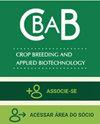Evidence of maternal effect on the inheritance of flax (Linum usitatissimum L.) seed coat color
IF 1.1
4区 农林科学
Q2 Agricultural and Biological Sciences
引用次数: 1
Abstract
Abstract This study aimed to investigate the presence of maternal effect on the inheritance of flax seed coat color. Direct and reciprocal crosses were performed between four yellow flax seed lines and two brown flax seed cultivars. F1 and F2 populations of direct and reciprocal crosses were evaluated for coat color. Four F2 populations were selected for analysis of coat color in the F3 generation. The phenotypic segregation pattern was assessed by the chi-square test. The nuclear genotype of the female parent influenced all F1, F2, and F3 populations. F1 and F2 seeds were always equal to the phenotype of the female parent. F3 populations had a 3:1 ratio of plants producing yellow and brown seeds. The maternal effect resulted from the transfer of gene products from maternal cytoplasm to offspring, with evidence of the effect of a single gene with a dominant allele for the yellow phenotype.母源对亚麻种皮颜色遗传影响的证据
本文章由计算机程序翻译,如有差异,请以英文原文为准。
求助全文
约1分钟内获得全文
求助全文
来源期刊
CiteScore
2.40
自引率
13.30%
发文量
25
审稿时长
6-12 weeks
期刊介绍:
The CBAB – CROP BREEDING AND APPLIED BIOTECHNOLOGY (ISSN 1984-7033) – is the official quarterly journal of the Brazilian Society of Plant Breeding, abbreviated CROP BREED APPL BIOTECHNOL.
It publishes original scientific articles, which contribute to the scientific and technological development of plant breeding and agriculture. Articles should be to do with basic and applied research on improvement of perennial and annual plants, within the fields of genetics, conservation of germplasm, biotechnology, genomics, cytogenetics, experimental statistics, seeds, food quality, biotic and abiotic stress, and correlated areas. The article must be unpublished. Simultaneous submitting to another periodical is ruled out. Authors are held solely responsible for the opinions and ideas expressed, which do not necessarily reflect the view of the Editorial board. However, the Editorial board reserves the right to suggest or ask for any modifications required. The journal adopts the Ithenticate software for identification of plagiarism. Complete or partial reproduction of articles is permitted, provided the source is cited. All content of the journal, except where identified, is licensed under a Creative Commons attribution-type BY. All articles are published free of charge. This is an open access journal.

 求助内容:
求助内容: 应助结果提醒方式:
应助结果提醒方式:


